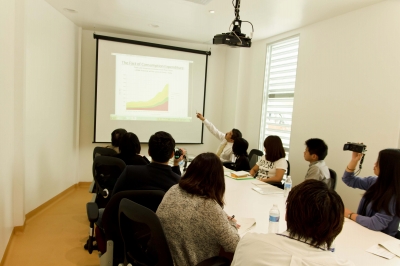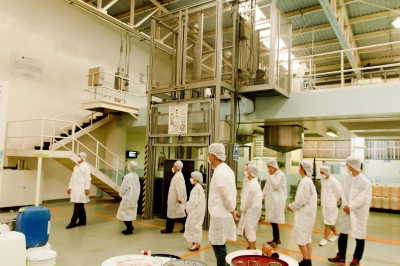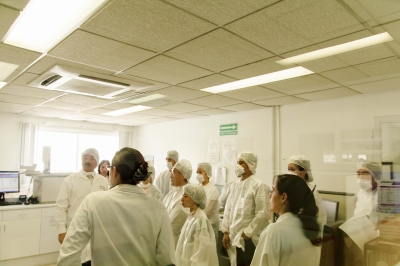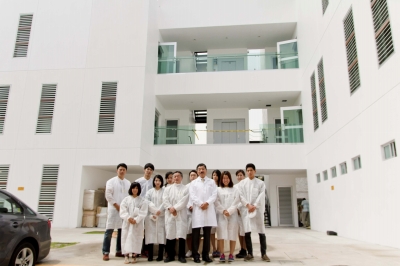Takasago De Mexico S.A. De C.V. Hosts Mission of Kanagawa University Students
On September 2, a combined group of 10 undergraduate and graduate students from the Department of Spanish of Kanagawa University (Kanagawa Prefecture, Japan), led by Professor Hidetaka Ogura of that department, paid a visit to Takasago De Mexico S.A. De C.V. (TDM). The group was on a “training mission” in Mexico with the purpose of learning about the current economic conditions and potential of that country and neighboring Latin American nations. This is a region that continues to earn keen attention from Japanese companies as a promising destination for business expansion. The program included visits to Japanese firms that have set up local operations there, to allow the student to become familiar with their situations. In addition to TDM, the group also visited operations of Toray Industries and Nissan Motor Co., Terumo Corp., the Japanese Chamber of Commerce and Industry of Mexico and other stops.

Explanations delivered in the first floor presentation room
of the TDM new flavor research wing.
The TDM visit began with brief explanations of Takasago International Corporation (TIC) and TDM. This was followed by a 90-minute presentation covering the topics of “The Current Status and Potential of the Economies of Mexico and Latin America,” “How Japanese Companies Expanding to the Region have Performed,” “Public Security Conditions and Countermeasures,” “Resident Employee Training of Local Staffers” and other subjects, capped off with a Q&A session. The group was then taken on tour of the TDM new flavor research wing and the company’s factory.

Inside the flavor mixing factory.
Mexico, besides offering superb advantages for its geopolitical location, also benefits from government policies leading to the recent stabilization of its current account balance, favorable trends in foreign currency reserves, the largest number of free trade agreements signed by any nation in the world and other clear progress. Moreover, Mexico has the world’ s most consumption-driven markets such as the United States and the developed countries of Latin America where household consumption accounts for between 50 to 60% of their GDPs. The current scale of the intra-regional consumer market for all of Latin America has risen to a level roughly equivalent to the combined total for China and India.
Group leader Professor Ogura is a former foreign service officer with specialties in the fields of international relations and Hispanic cultural affairs. He has also lived for a total of 16 years in different Latin American nations in the past. Professor Ogura became keenly aware of the potential of the markets in that part of the world from early on, and expressed hearty agreement with the information and conclusions contained in the TDM presentation.
Among Japanese companies, manufacturers of electric machinery, automobiles and other consumer durables expanded operations to Mexico years ago. Also well reported over the past several years have been the launches of new factories by three Japanese automakers and advances by numerous affiliated companies on the market there. Western companies gradually expanded to Mexico, first general consumer goods companies and then consumer durable makers, hand in hand with the development of the local consumer market. In comparison, very few Japanese general consumer producers have engineered such moves as yet. However, against the backdrop of the high Mexican birthrate and forecasts that the increase in the local workingage population will continue beyond 2040, several Japanese disposable diaper producers have recently expressed the desire to set up shop there.

Viewing the GC lab in the TDM quality control division.
Mexico tends to be plagued by the impression that its public security is rather poor. A closer examination of the realities, however, shows that the majority of violence and other incidents occur between competing drug cartels, as well as government forces striving crack down on such crimes. As a result, there is little or no terrorism targeting the public on an indiscriminate basis. For companies and individuals, therefore, exercising normal cautions on a daily basis, becoming well versed in public security and safety measure manuals and following other risk management procedures renders it possible to avoid almost all problems. It was explained that it is particularly important to shift away from the conviction that Japan and certain other industrialized advanced countries are “exceptionally safe” in an overall global context.

Group photo shot in front of the new flavor research wing.
The students also expressed keen interest in the fact that Mexican preferences for everyday cosmetics, food flavors and fragrances and other tastes are extremely similar to those in Southeast Asia. Both regions share much in common both historically and culturally – particularly, the fusion between European and local cultures from days of old. The climates in both areas stretch from subtropical to tropical zones, while ethnically there have been large numbers of persons of mixed racial backgrounds from traditional mongoloid groups of native populations and the Caucasians that arrived in the regions during their respective colonial eras. In these and other ways, both regions are quite fascinating from a cultural anthropological perspective.